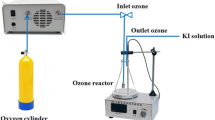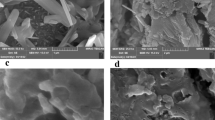Abstract
A novel biomass carbon doped with dual-metal oxide mischcrystal (cobalt oxide and molybdenum oxide) was synthesized by using Enteromorpha (EP) of marine algae as carbon source. Multi-wrinkles biomass carbon (MWBC) with magnetic properties was obtained and formed highly dispersed CoOx/MoOy nanoparticles onto the surface of MWBC in situ via a simple impregnation and direct carbonization at 700 °C. The framework of CoOx/MoOy@MWBC was characterized by scanning electron microscopy, transmission electron microscope, X-ray diffraction and X-ray photoelectron spectroscopy. The as-prepared CoOx/MoOy@MWBC was applied as efficient adsorbents for selective removal methyl blue (MB) at pH 10 from water medium. For comparison, single metal-derived porous carbon, i.e., CoOx@MWBC and MoOy@MWBC, was also synthesized, characterized and tested for MB adsorption. The results exhibited that CoOx/MoOy@MWBC has the highest MB adsorption capacity (1587.3 mg g−1) and excellent selectivity. In addition, it could be easily separated from water by an external magnetic field without any organic reagent added. Adsorption equilibrium data were described by Langmuir and Freundlich isotherms, and kinetic data were described by pseudo-first-order, pseudo-second-order and intraparticle diffusion model. Moreover, CoOx/MoOy@MWBC also owned outstanding stability and renewability, which can be regenerated by an easy-going method of ethanol washing and reused at least 10 times without a significant loss in removal percentage.








Similar content being viewed by others
References
Gagol M, Przyjazny A, Boczkaj G (2018) Wastewater treatment by means of advanced oxidation processes based on cavitation-a review. Chem Eng J 338:599–627
Li N, Zhao P, Astruc D (2014) Anisotropic gold nanoparticles: synthesis, properties, applications, and toxicity. Angew Chem Int Ed 53:1756–1789
Abdi J, Vossoughi M, Mahmoodi NM, Alemzadeh I (2017) Synthesis of metal-organic framework hybrid nanocomposites based on GO and CNT with high adsorption capacity for dye removal. Chem Eng J 326:1145–1158
Esmaeili H, Foroutan R (2018) Adsorptive behavior of methylene blue onto sawdust of sour lemon, date palm, and eucalyptus as agricultural wastes. J Disper Sci Technol. https://doi.org/10.1080/01932691.2018.1489828
Mahini R, Esmaeili H, Foroutan R (2018) Adsorption of methyl violet from aqueous solution using brown algae Padina sanctae-crucis. Turk J Biochem 43:623–631
Lau W-J, Ismail AF (2009) Polymeric nanofiltration membranes for textile dye wastewater treatment: preparation, performance evaluation, transport modelling, and fouling control—a review. Desalination 245:321–348
Li Q, Li Y, Ma X et al (2017) Filtration and adsorption properties of porous calcium alginate membrane for methylene blue removal from water. Chem Eng J 316:623–630
Jiang L, Yuan X, Zeng G et al (2018) Metal-free efficient photocatalyst for stable visible-light photocatalytic degradation of refractory pollutant. Appl Catal B Environ 221:715–725
Liang C-Z, Sun S-P, Li F-Y, Ong Y-K, Chung T-S (2014) Treatment of highly concentrated wastewater containing multiple synthetic dyes by a combined process of coagulation/flocculation and nanofiltration. J Membr Sci 469:306–315
Santhosh C, Velmurugan V, Jacob G, Jeong SK, Grace AN, Bhatnagar A (2016) Role of nanomaterials in water treatment applications: a review. Chem Eng J 306:1116–1137
Ganzenko O, Trellu C, Papirio S et al (2018) Bioelectro-Fenton: evaluation of a combined biological-advanced oxidation treatment for pharmaceutical wastewater. Environ Sci Pollut Res 25:20283–20292
Huang H, Liu J, Zhang P, Zhang D, Gao F (2017) Investigation on the simultaneous removal of fluoride, ammonia nitrogen and phosphate from semiconductor wastewater using chemical precipitation. Chem Eng J 307:696–706
Verma AK, Dash RR, Bhunia P (2012) A review on chemical coagulation/flocculation technologies for removal of colour from textile wastewaters. J Environ Manag 93:154–168
Vijwani H, Nadagouda MN, Namboodiri V, Mukhopadhyay SM (2015) Hierarchical hybrid carbon nano-structures as robust and reusable adsorbents: kinetic studies with model dye compound. Chem Eng J 268:197–207
Cao Y, Huang J, Li Y et al (2016) One-pot melamine derived nitrogen doped magnetic carbon nanoadsorbents with enhanced chromium removal. Carbon 109:640–649
Cao Y, Huang J, Peng X et al (2017) Poly(vinylidene fluoride) derived fluorine-doped magnetic carbon nanoadsorbents for enhanced chromium removal. Carbon 115:503–514
Ma Y, Lv L, Guo Y et al (2017) Porous lignin based poly (acrylic acid)/organo-montmorillonite nanocomposites: swelling behaviors and rapid removal of Pb(II) ions. Polymer 128:12–23
Chen C, Huang H, Yu Y, Shi J, He C, Albilali R, Pan H (2018) Template-free synthesis of hierarchical porous carbon with controlled morphology for CO2 efficient capture. Chem Eng J 353:584–594
Baikousi M, Bourlinos AB, Douvalis A et al (2012) Synthesis and characterization of gamma-Fe2O3/Carbon hybrids and their application in removal of hexavalent chromium ions from aqueous solutions. Langmuir 28:3918–3930
Hu J, Shao D, Chen C, Sheng G, Li J, Wang X, Nagatsu M (2010) Plasma-induced grafting of cyclodextrin onto multiwall carbon Nanotube/Iron oxides for adsorbent application. J Phys Chem B 114:6779–6785
Wu Z, Li W, Webley PA, Zhao D (2012) General and controllable synthesis of novel mesoporous magnetic iron Oxide@Carbon encapsulates for efficient arsenic removal. Adv Mater 24:485–491
Zhang R, Zhang J, Zhang X, Dou C, Han R (2014) Adsorption of Congo red from aqueous solutions using cationic surfactant modified wheat straw in batch mode: kinetic and equilibrium study. J Taiwan Inst Chem Eng 45:2578–2583
Hugo Luis-Zarate V, Cecilia Rodriguez-Hernandez M, Alatriste-Mondragon F, Felipe Chazaro-Ruiz L, Rene Rangel-Mendez J (2018) Coconut endocarp and mesocarp as both biosorbents of dissolved hydrocarbons in fuel spills and as a power source when exhausted. J Environ Manag 211:103–111
Kooh MRR, Dahri MK, Lim LBL (2018) Jackfruit seed as low-cost adsorbent for removal of malachite green: artificial neural network and random forest approaches. Environ Earth Sci 77(12):434
Aranda-Garcia E, Cristiani-Urbina E (2018) Kinetic equilibrium, and thermodynamic analyses of Ni (II) biosorption from aqueous solution by acorn shell of quercus crassipes. Water Air Soil Pollut 229(4):119
Teimouri A, Esmaeili H, Foroutan R, Ramavandi B (2018) Adsorptive performance of calcined Cardita bicolor for attenuating Hg(II) and As (III) from synthetic and real wastewaters. Korean J Chem Eng 35:479–488
Ghaedi M, Ghaedi AM, Negintaji E, Ansari A, Vafaei A, Rajabi M (2014) Random forest model for removal of bromophenol blue using activated carbon obtained from Astragalus bisulcatus tree. J Ind Eng Chem 20:1793–1803
Ou J, Zhang Y, Chen L, Zhao Q, Meng Y, Guo Y, **ao D (2015) Nitrogen-rich porous carbon derived from biomass as a high performance anode material for lithium ion batteries. J Mater Chem A 3:6534–6541
Qian W, Zhu J, Zhang Y, Wu X, Yan F (2015) Condiment-derived 3D architecture porous carbon for electrochemical supercapacitors. Small 11:4959–4969
She X, Yang D, **g D, Yuan F, Yang W, Guo L, Che Y (2014) Nitrogen-doped one-dimensional (1D) macroporous carbonaceous nanotube arrays and their application in electrocatalytic oxygen reduction reactions. Nanoscale 6:11057–11061
Yao Z, Su Y, Lu C, Yang C, Xu Z, Zhu J, Zhuang X, Zhang F (2016) Template-directed approach to two-dimensional molybdenum phosphide-carbon nanocomposites with high catalytic activities in the hydrogen evolution reaction. New J Chem 40:6015–6021
Wu Z, Wang J, Zhu J, Guo J, **ao W, Xuan C, Lei W, Wang D (2017) Highly efficient and stable MoP-RGO nanoparticles as electrocatalysts for hydrogen evolution. Electrochim Acta 232:254–261
Mousavi SM, Hashemi SA, Esmaeili H, Amani AM, Mojoudi F (2018) Synthesis of Fe3O4 nanoparticles modified by oak shell for treatment of wastewater containing Ni(II). Acta Chim Slov 65:750–756
Mahmoodi NM, Hayati B, Arami M (2012) Kinetic equilibrium and thermodynamic studies of ternary system dye removal using a biopolymer. Ind Crop Prod 35:295–301
Abshirini Y, Foroutan R, Esmaeili H (2019) Cr(VI) removal from aqueous solution using activated carbon prepared from Ziziphus spina-christi leaf. Mater Res Express 6(4):045607
Khoo FS, Esmaeili H (2018) Synthesis of CaO/Fe3O4 magnetic composite for the removal of Pb(II) and Co(II) from synthetic wastewater. J Serb Chem Soc 83(2):237–249
Mahmoodi NM, Abdi J, Najafi F (2013) Gemini polymeric nanoarchitecture as a novel adsorbent: synthesis and dye removal from multicomponent system. J Colloid Interface Sci 400:88–96
Ahmadi F, Esmaeili H (2018) Chemically modified bentonite/Fe3O4 nanocomposite for Pb(II), Cd(II), and Ni(II) removal from synthetic wastewater. Desalin Water Treat 110:154–167
Tamjidi S, Esmaeili H (2019) Chemically modified CaO/Fe3O4 nanocomposite by sodium dodecyl sulfate for Cr(III) removal from water. Chem Eng Technol 42(3):607–616
Jang HM, Yoo S, Choi Y-K, Park S, Kan E (2018) Adsorption isotherm, kinetic modeling and mechanism of tetracycline on Pinus taeda-derived activated biochar. Bioresour Technol 259:24–31
Syafiuddin A, Salmiati S, Jonbi J, Fulazzaky MA (2018) Application of the kinetic and isotherm models for better understanding of the behaviors of silver nanoparticles adsorption onto different adsorbents. J Environ Manag 218:59–70
Acknowledgements
Financial support from National Natural Science Foundation of China (No. 81673172, 21475144 and 91227116), Postdoctoral Science Foundation of China (2018M642615), Natural Science Foundation of Shandong province (ZR2017BB053) and Major Program of Shandong Province Natural Science Foundation (ZR2018ZC0125) are highly appreciated.
Author information
Authors and Affiliations
Corresponding author
Additional information
Publisher's Note
Springer Nature remains neutral with regard to jurisdictional claims in published maps and institutional affiliations.
Electronic supplementary material
Below is the link to the electronic supplementary material.
Rights and permissions
About this article
Cite this article
Yang, L., Wang, Y., Liu, A. et al. CoOx/MoOy-anchored multi-wrinkled biomass carbon as a promising material for rapidly selective methyl blue removal. J Mater Sci 54, 11024–11036 (2019). https://doi.org/10.1007/s10853-019-03612-7
Received:
Accepted:
Published:
Issue Date:
DOI: https://doi.org/10.1007/s10853-019-03612-7




